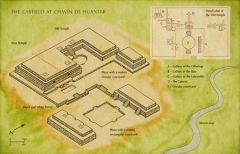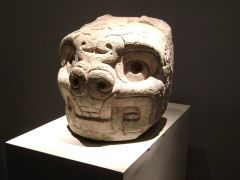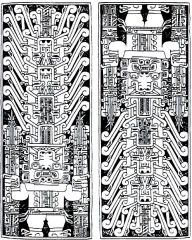![]()
![]()
![]()
Use LEFT and RIGHT arrow keys to navigate between flashcards;
Use UP and DOWN arrow keys to flip the card;
H to show hint;
A reads text to speech;
11 Cards in this Set
- Front
- Back
|
Huaca |
Quechua word referring to an object or place in which sacred power was immanent. |
|
|
Axis Mundi |
"Center of the world" |
|
|
Contour Rivalry |
The same set of lines belong to two images at once to create a dual image. |
|
|
Metaphoric Substitution |
One image stands in for something else |
|
|
Vilca |
Psychotropic plant substance |
|
|
Tinquy |
Quechua term meaning "harmonious meeting of opposite forces" |
|
|
Key Work: Reconstruction of temple at Chavin de Huantar (pg. 38) 1100 BCE - 500 BCE
Impractical designs for the environment it was built (flat roofs and buildings as high as 3 stories -> earthquakes, heavy rainfall)
Secluded space, faces east (sun rising), u-shaped complex echoing the mountains on either side, built out of materials brought in from elsewhere (shows evidence of trade/reciprocity, survival), designed like an amphitheater (sense of theatrical environment - people coming together to watch something) Synthesis of coastal and highland architecture - appropriated styles
Fundamental principles of complex: Trade/reciprocity, duality, verticality
Spiritual pilgrimage site |

|
|
|
Key Work: Relief panel of parading shaman and jaguar (pg. 42) 1100 BCE - 500 BCE, Late Initial- Early Horizon Found in the Sunken Circular Court in front of the Old Temple, relief panels of parading shamans carrying [entheogenic] San Pedro cactus, partially transformed into jaguar - animals and human pairs arranged around courtyard Anthropomorphic |

|
|
|
Key Work: Lanzón (pg. 39) late initial - early horizon, 1100 BCE - 500 BCE Spanish for "spear" (blade-like form) - shape refers to the lowland Amazonian foot plow Located deep inside the center of the Old Temple, narrow and dark -> shift from communal to private space familiar imagery, odd shape Massive figure of the early Chavin supreme deity gestures up and down to encompass all realms (verticality) Temple built around this monolithic sculpture Most important Chavin cult image, 15 ft high - embedded in the floor and penetrating the ceiling, acted as a supernatural conduit - priest spoke for the Lanzon as an oracle right arm up, left arm down = an all-encompassing gesture that controls and unites celestial and terrestrial spheres. Because there was no way for natural sunlight to penetrate inside and no evidence showing use of torches, there is scant evidence that this structure was never even visible to a human audience --> theory that the ducts running through the temple could have been used to shed indirect light on the interior ^ the essence of the object take precedence over the straightforward act of beholding it in this place of existence Spiritual exclusivity = only a small handful of Chavin shamans may have barely glimpsed at the Lanzon Contour rivalry - one thing can be two depending on how you look at it |

|
|
|
Key Work: Tenon Heads (pg. 46) Late Initial- Early Horizon, 1100 BCE - 500 BCE Found attached to the high walls of the Old Temple, Encapsulates the spectacular transformation of the trancing shaman into a monstrous animal spirit 1st things you see when you enter Chavin, creates an authoritative and intimidating space - looking down at you as you enter All unique Theory: arranged in a sequence from most human to most animal - western way of thinking --> these heads were probably used to show some kind of transformation but not necessarily in a linear way |

|
|
|
Key Work: Drawing of Raimondi Stela (pg. 49) Late Initial - Early Horizon, 1100 BCE - 500 BCE Intense Contour Rivalry! 2 completely different images, using the same lines Verticality - 1 image is ascending, 1 is descending, 1 is more human, 1 is more animal Duality - distinct earthly and celestial entities are one and the same Could have been placed upright, in the ceiling, or on the floor - no way to know You must be constantly moving around it in order to grasp and absorb all of the various images because remaining stationary doesn't allow you to see all that you can. Supernatural figure, predominantly agricultural and fertility associations |

|

